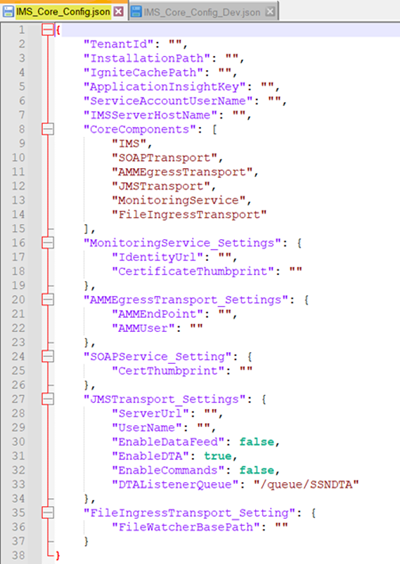Core Services JSON Configuration File
The installation configuration JSON file (IMS_Core_Config.json) defines the attributes for core services.

Note: If you are not installing all services on the same server, some of the services listed in the CoreComponents configuration in the IMS_Core_Config.json file will be removed. It is recommended that the IMS and MonitoringService services are installed on the core (primary) server and the remaining services are installed on the secondary (client) server. For example: Core components on the primary server "CoreComponents": [ "IMS", "MonitoringService" ], Core components on the client server "CoreComponents": [ "SOAPTransport", "AMMTransport", "JMSTransport" ], |
The installation configuration JSON file for core services contains the following elements:
TenantId. Tenant ID for IMS to be configured.
InstallationPath. Used by all services to extract the service binaries and run services from this path. For example:
F:\\HostApps
Caution: The InstallationPath location should not be a network shared path.
IgniteCachePath. Used to load the Apache Ignite cache to store the Ignite data files and other Ignite-related files. This can be a network shared path or any local drive path with sufficient memory and I/O throughput (recommended). For example:
\\\ims-ignite.itron.com\IgniteCache (network path)
or
D:\\IgniteCache (local drive)
ApplicationInsightKey. (Optional) The Microsoft Azure Application Insight key used to capture logs. If the key is available, assign it as the value for this setting. Otherwise, keep the default value, which is NA.
ServiceAccountUserName. The domain user service account running the IMS services for this account. The user name should use the fully qualified domain name (FQDN) format (for example: IMSAdmin@itron.com or IMSAdmin@subitron.itron.local). This user should have full control access to InstallationPath.
Note: If the FQDN is subitron.itron.local, then the user name should be UserName@subitron.itron.local. If the FQDN is itron.com, then the user name should be UserName@itron.com. These credentials are used to validate against Active Directory or domain authentication.
IMSServerHostName. The IMS Server Full Name (for example: ims-prod-primary.itron.com).
CoreComponents. The list of services that comprise the IMS core components:
[ "IMS", "SOAPTransport", "AMMTransport", "JMSTransport", "MonitoringService" ]
Important! Remove any services from this list that are not being installed on the server on which you are running the installation. Make sure that this list is correct before running the installation to prevent duplicate service installations on multiple servers.
IdentityUrl. The Identity Server URL used by the monitoring service for authentication and authorization. For example:
https://idenservertest2.itrontotaltest.com/
or
https://ims-iden.itron.com:10800/
Note: This can be the same Identity Server that is used for IEE Edge Explorer if already installed in your environment.
CertificateThumbprint. The SSL certificate thumbprint for hosting the monitoring service as a secured endpoint. For example:
13fb7dcadd430df19213b7bbe460d55401606414
Note: If you don't want to host the monitoring service as a secured endpoint, set the value to NA. This will host the monitoring service as an unsecured endpoint (not recommended).
AMMEndPoint. The AMM API endpoint used for two-way command request responses. For example:
https://mt.shared-50x-install.eng.ssnsgs.net:3009
Note: This endpoint should be reachable during installation of the AMMTransport service. The connectivity will be checked as part of the pre-check validation during installation.
AMMUser. The AMM API endpoint username for authentication.
JMSTransport_Settings/ServerUrl. The JMS endpoint to receive results.
Note: This endpoint should be reachable during the installation of the JMSTransport service. The connectivity will be checked as part of pre-check validation during installation.
JMSTransport_Settings/UserName. The JMS username for authentication.
JMSTransport_Settings/EnableDataFeed. Enables JMSTransport to create a listener for DataFeeds.
JMSTransport_Settings/EnableDTA. Enables JMSTransport to create a listener for the Data Transform Adapter (DTA).
JMSTransport_Settings/EnableCommands. Enables JMSTransport to create a listener for two-way command responses.
JMSTransport_Settings/EnableEvents. Enables JMSTransport to create a listener for the Events response.
JMSTransport_Settings/DTAListenerQueue. Queue name for the DTA listener.
CertThumbprint. The SSL certificate thumbprint (without spaces) for the SOAP Transport service to provide secure endpoint data to an external system. For example:
13fb7dcadd430df19213b7bbe460d55401606414